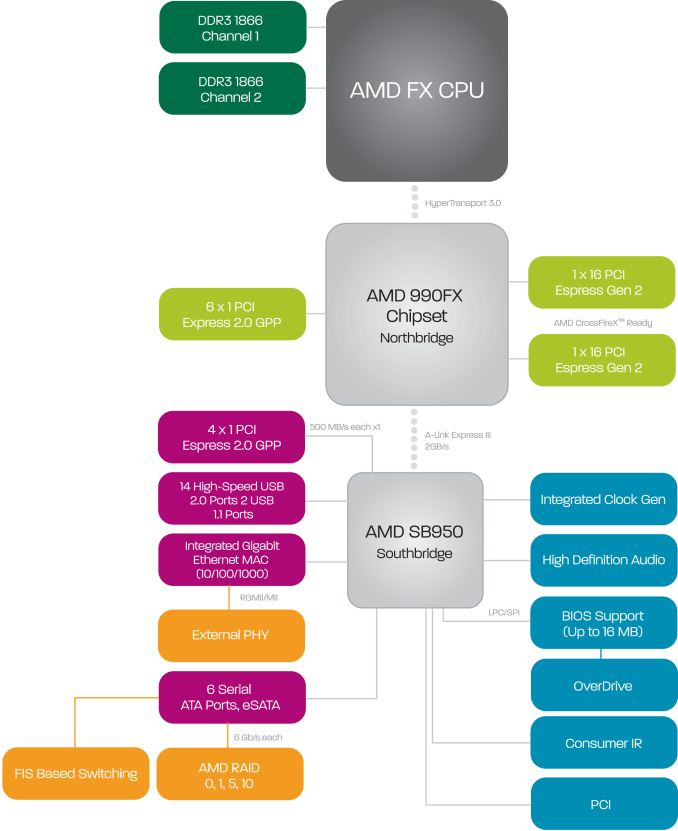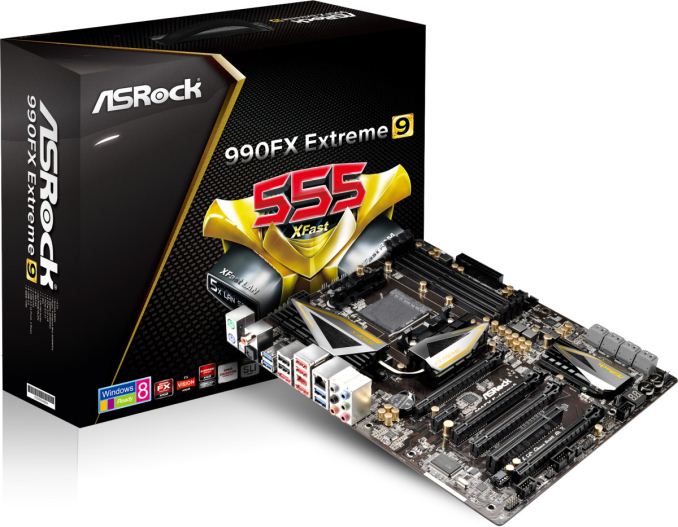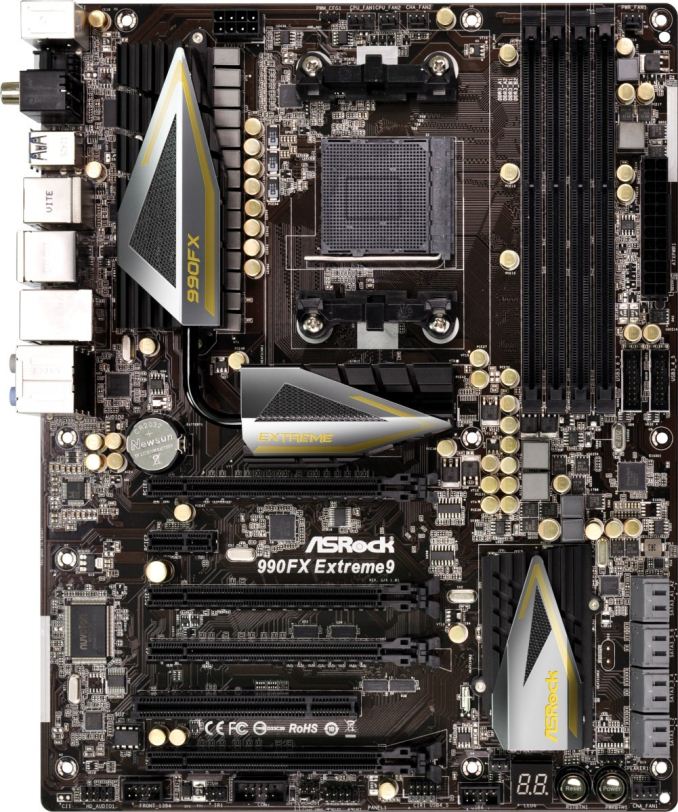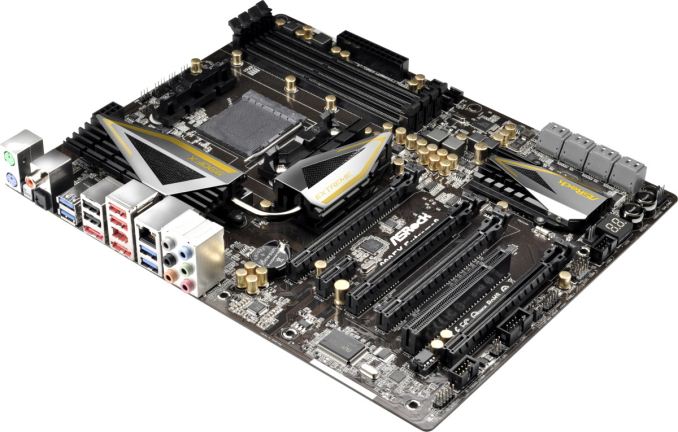AMD’s 5 GHz Turbo CPU in Retail: The FX-9590 and ASRock 990FX Extreme9 Review
by Ian Cutress on August 9, 2014 8:00 AM ESTFor new users to the PC industry, or those that migrated towards newer APU platforms, it is worth going back and recalling the AM3+ socket with the 990FX chipset. When the platform was released, it offered several advantages that Intel lacked at the time: a full set of SATA 6 Gbps ports was the main advantage which took Intel another two generations to offer. The chipset, with the right CPU, also offered substantially more PCIe lanes than the mainstream Intel parts which were similarly priced. While the user could have sixteen PCIe 2.0 lanes from an Intel CPU for graphics coupled with eight PCIe 2.0 lanes from the chipset, AMD users had 32 PCIe 2.0 lanes from the CPU for graphics, another six PCIe 2.0 x1 lanes for controllers and four PCIe 2.0 x1 lanes from the chipset. This gave the AMD motherboard manufacturers more bandwidth to add extra ports or adjust their PCIe layout for graphics. Note that this is the latest AMD platform to support SLI, rather than the newer FM1/FM2 platforms that do not.
There are a few limitations on the 990FX chipset worth mentioning. When this motherboard we are testing today was released, PCIe 3.0 was gaining momentum. The only way to add PCIe 3.0 to these motherboards was to integrate a PLX chip between the Northbridge and the GPUs which gave PCIe 3.0 capabilities between the GPUs, but it still limited data transfer between the PLX chip and the CPU to PCIe 2.0. The other limitation was one of cost. AMD platforms have historically been low cost markets, at least for end users, which correlates to a reluctance to expand spending on motherboards. This reduces the market for high end motherboard solutions which might incorporate extra features and controllers, and as a result many AM3+ motherboards were aimed at price/performance rather than feature set.
The ASRock 990FX Extreme9 sits near the top of the stack for feature set, and currently retails for $170. To put that into perspective, we discuss $170 motherboards for Intel’s latest chipsets as a mid-range point rather than the high end.
Also worth noting that because our last 990FX reviews were with the FX-8150 processor, in order to compare to historical data we also used the Extreme9 with the FX-8150 for comparison points.
ASRock 990FX Extreme9 Overview
Visual Inspection
Taking the motherboard out of the box for the first time and there are several items worth noting. Firstly the extended heatsink which covers the 12+2 phase power delivery to the side of the socket and the North Bridge just below the socket. ASRock has placed all the power delivery chokes in a line, and uses a CHIL8328 IC for a digital design. This PWM controller powers 6-8 phases, and thus the system uses multiplexing to get the desired 12 for the CPU voltage.
The socket area has four fan headers within immediate reach – two CPU and one chassis header directly above the socket, and a 3-pin PWR header to the top right of the DRAM slots. The other two fan headers on the motherboard are located at the bottom, one to the left of the 2-digit debug and the other to the right of the power/reset buttons. The socket area uses a low heatsink profile combined with a gap to the DRAM that should allow for large air coolers to be used.
The DRAM slots use double sided latch mechanisms and there is ample space to the first major PCIe slot. At the bottom of the DRAM slots, to the right, are two USB 3.0 headers from an Etron EJ188H controller. At the time this motherboard was made, a chassis may have had one USB 3.0 header, and thus ASRock also includes a USB 3.0 panel in the box.
Underneath this are eight SATA 6 Gbps ports, the top two from an ASMedia ASM1061 controller followed by six from the south bridge. In this situation, with an additional controller, I would have preferred if ASRock had used a different color for the ASMedia ports. Below these is a fan header, the power and reset buttons, and the two-digit debug.
At the bottom of the motherboard is an IEEE1394 header, a COM header, two USB 2.0 headers, an IR header and the front panel headers. Above this is the odd PCIe layout, which combines the 32 PCIe 2.0 lanes from the north bridge with another PCIe 2.0 x4.
The layout is such that the top PCIe slot is an x16, followed by an x1. The second full length slot is a PCIe 2.0 x4, followed by another PCIe 2.0 x16. This slot shares bandwidth with the bottom PCIe slot, whereby if the bottom is populated, they both go to PCIe 2.0 x8. There is also a PCI slot near the bottom.
This means:
Configuration 1: x16/x1/x4/x16/PCI/-
Configuration 2: x16/x1/x4/x8/PCI/x8
Having this layout allows the user to equip the board with three GPUs in the first, third and fourth full length slots. If they are double slot cards, the PCIe 2.0 x4 is left vacant for a sound card, network card, RAID card or other PCIe device. It is worth noting that in terms of audio, ASRock has equipped this motherboard with a Realtek ALC898 codec.
The rear panel uses two PS/2 ports, one for mouse and one for keyboard, followed by a ClearCMOS button and SPDIF outputs. The four blue USB 3.0 ports are powered by another Etron EJ188H controller, and the panel also has four USB 2.0 ports with two eSATA 6 Gbps ports. The IEEE1394 port on the rear is perhaps one of the last consumer oriented motherboard to have this port pre-installed. The Intel NIC on the rear IO might seem a little strange on an AMD motherboard, but this is one of the top line 990FX solutions. The audio jacks round off the set.
Board Features
| Board Features | |
| Price | US (Newegg) |
| Size | ATX |
| CPU Interface | Socket AM3+ |
| Chipset | 990FX + SB950 |
| Memory Slots |
Four DDR3 DIMM slots supporting up to 32 GB Up to Dual Channel, 1066-2450 MHz |
| Video Outputs | None |
| Onboard LAN | Intel 82583V |
| Onboard Audio | Realtek ALC898 |
| Expansion Slots |
3 x PCIe 2.0 x16 (x16/x16/- or x16/x8/x8) 1 x PCIe 2.0 x4 1 x PCIe 2.0 x1 1 x PCI |
| Onboard SATA/RAID |
6 x SATA 6 Gbps (Chipset), RAID 0,1,5,10 2 x SATA 6 Gbps (ASMedia ASM1061) |
| USB 3.0 |
4 x Rear USB 3.0 (Etron EJ188H) 2 x USB 3.0 Headers (Etron EJ188H) |
| Onboard |
8 x SATA 6 Gbps Ports 2 x USB 3.0 Headers 2 x USB 2.0 Headers 6 x Fan Headers 1 x COM Header Power/Reset Switches Dr. Debug LED Front Panel Connector Front Audio Connector |
| Power Connectors |
1 x 24-pin ATX 1 x 8-pin CPU |
| Fan Headers |
2 x CPU (4-pin, 3-pin) 3 x CHA (4-pin, 2x 3-pin) 1 x PWR (3-pin) |
| IO Panel |
1 x PS/2 Keyboard 1 x PS/2 Mouse 4 x USB 2.0 4 x USB 3.0 2 x eSATA 6 Gbps 1 x IEEE1394 1 x Intel NIC Clear CMOS Switch Audio Jacks |
| Warranty Period | 3 Years |
| Product Page | Link |
If we were making a high end AMD motherboard for 2014, the extra lanes would be perfect for PCIe storage. Pile on a SATA Express and M.2 x4 slot without losing lanes to other functions. Some native USB 3.0 would be nice, or 3.1 via controllers. PCIe 3.0 support would be a must of course, along with a Realtek ALC1150 or more advanced audio codec. ASRock’s latest motherboards have featured a water-proof/superhydrophobic coating, or small LCD panels to aid in overclocks, which might be something in AMD meets 2014.















146 Comments
View All Comments
NeatOman - Saturday, August 9, 2014 - link
I have a FX-8320 @4.5Ghz, and never goes over 75c. I got it because it was $215 for both the CPU and a very good motherboard, and paired it with two HD 7850's. With that said, an overclocked i5@4.4Ghz is better then anything AMD can do over clocked even @5Ghz (for the most part) and at times far out classes it. But, an i5 and good motherboard will cost about $350 and $400+ for i7.. Almost twice. FYI, I live in Illinois and the electricity here is very very cheap.colinstu - Saturday, August 9, 2014 - link
a $300+ AMD chip?! LOL. Who the heck would buy this? It's not efficient, it's definitely not fast compared to $100 cheaper intel offerings (or similarly priced offerings in some of the other benches).swizeus - Saturday, August 9, 2014 - link
Second your opinion... It has been 3rd generation (or more ?) since FX gone out the door and AMD should have a solution to at least match Intel's performance by now, but why this ? It is pointless to have a power hungry beast that lost in the match with a processor that is halved in TDP in an Unzipping archive operation, not to mention electricity bill and the noise to cool down 220Watt TDP Processor... Not worth itRussianSensation - Sunday, August 10, 2014 - link
The amount of generations or the time span doesn't have any correlation with AMD catching up. Take an i7 4790K and manufacture it in 28-32nm node and see how awful it is. In other words, unless AMD can manufacture chips on the same node as Intel, it has no chance of competing whatsoever even if by magic their CPUs had identical IPC and clocks to Intel's. The delta in performance and performance/watt will only grow once Intel launches Skylake on 14nm next year.Budburnicus - Wednesday, March 11, 2015 - link
Umm a 4790K even at 32nm would still spank this chip across the board. How "awful" indeed...I mean forget the 4790K for a second, the 2600K at STOCK will beat this CPU out in nearly everything. and basically any i7-2600k on any board that supports overclocking WILL easily hit 4.2-4.4 - hell I had mine at 4.4 with a STOCK POS Intel Heatsink (POS in terms of its ability to cool, it is actually more than effective enough with how little heat the CPUs generate) - And at those speeds the 2600K beats out any and every AMD consumer CPU at almost everything, and what few benchmarks it will be behind in, it will not be by too much. And those benchmarks would include only VERY highly multithreaded applications of computational power - basically, server-type stuff. Certainly not in gaming!
Then there's the NEWER Intel CPUs like the i7-5930K (which I also own) which aren't too much more expensive than this flop, and will beat it out in absolutely anything and everything - at stock clocks again! With the exact same CoolerMaster Hyper 212 EVO I have on my i7-2600K machine (AWESOME cooler for the money, though I will probably replace the one currently on the 5930, as it does not provide the maximum OC headroom possible like it does on my 2600 machine) - with dual fans, I have all cores running totally stable at 4.4 GHz with 105.7 Bclock!
AMD really needs to dump this architecture for the consumer class entirely (though I admittedly am not too familiar with Server-class CPU benchmarks, from what I have read the newer Intel Xeon are spanking the current Opterons, but IIRC they still represent good value for money in the high end workstation and server classes - though Enthusiasts generally seem to stick with the Xeons as they like to be able to game at insane speeds and resolutions as well as do encoding, editing, CAD, etc. As I have seen quite a few "ULTIMATE Rig builds" where money is no issue, by people like NCIX, Linus Tech tips, PCper, and others on YouTube, but I have yet to see an ultimate Opteron machine)
So, yeah... All that speaks volumes to people who look at information objectively and without bias. IF AMD were to come out with a new chip tomorrow which not only spanked everything Intel has ever made, but also made it cheap like the original SandyBridge parts - and therefore changed the game, DAMNED right I would be coveting a brand new AMD rig, and would likely sell off my 2600K machine, despite my deep love for it (and the fact that it games slightly better than the 5930 due to higher core speeds by a decent bit) to try to fund such a build ASAP!
But as it is? You would have to be a blind fanboy to buy a CPU like this for a brand new build, as it does not perform well and eats power like crazy, requiring AMD to bundle a friggen AIO water-block with it! And even with the best of the best, it will BARELY overclock! So the stock speed benchmarks will never be too far from a sustainable, stable, overclock - a FAR different story from the i5-i7 2000-5000 K series CPUs - as I said, a pretty average overclock on an i7-2600K is 4.2 GHz, a full 1 GHz above stock speeds, as the 3.8 GHz turbo only works when a single core is under load, and even then it will still beat out tthis 5950 in most ways!
lurker22 - Saturday, August 9, 2014 - link
Is AMD even trying anymore? That power draw is PATHETIC in the year 2014xdrol - Saturday, August 9, 2014 - link
I think the fact that this very processor is still 'the' flagship shows that no, they are not even trying.TiGr1982 - Saturday, August 9, 2014 - link
No, they actually don't. This is just cherry-picked and overclocked FX-8350 from October 2012 with all the associated power draw and heat growing superlinearly because of the much higher operating voltage.However, AMD does develop their CPU side of the business, but since Kaveri this January the results go only into APUs (same will happen with Carrizo coming next year).
AMD APUs are actually very fine in their class, they are just in a shy situation regarding these factory overclocked 220W FXes. The rest of their lineup is fine.
StrangerGuy - Saturday, August 9, 2014 - link
300W alone for a CPU, holy mother of god. An entire Haswell gaming rig with 750 Ti would probably draw less power.BTW $250 is insane for any motherboard let alone an AMD one. That's an i5 4590 and a budget mobo right there already.
Daniel Egger - Saturday, August 9, 2014 - link
> 300W alone for a CPU, holy mother of god. An entire Haswell gaming rig with 750 Ti would probably draw less power.Don't know where you got that 300W from but yes, a decent Haswell system with 750 TI will not just probably but definitely draw less power than 300W. Mine takes around 35W idle and up to 120W in games.